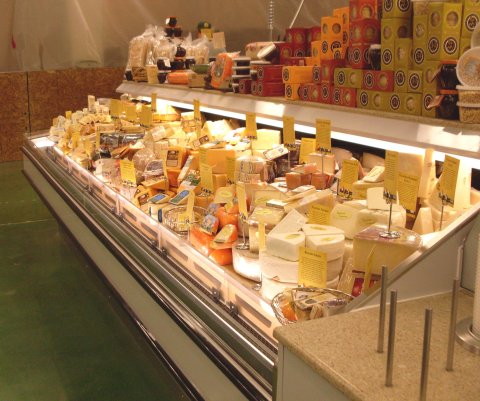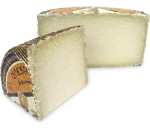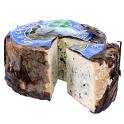The European Union Has 1000th Quality Food Name Registered
February 16, 2011
Very interesting article about how the EU is protecting the quality of certain specialty foods – bravo!!
From euroalert.net
published on Tuesday, February 15, 2011 under Agriculture & Fisheries
 On 15 February 1000th quality food products are registered by the European Commission. The latest one has been an Italian sheep’s cheese. On the other hand, Spain has 146 products in this record. In addition, the Commission considers these schemes essential for fast start-up of ‘Quality Package 2010’, by introducing several regulations that are bringing the production to the quality criteria demanded by consumers.
On 15 February 1000th quality food products are registered by the European Commission. The latest one has been an Italian sheep’s cheese. On the other hand, Spain has 146 products in this record. In addition, the Commission considers these schemes essential for fast start-up of ‘Quality Package 2010’, by introducing several regulations that are bringing the production to the quality criteria demanded by consumers.
The European Commission has registered on February 15, the one thousandth quality food name. The ‘Piacentinu Ennes’, an Italian sheep’s cheese, held in the Sicilian province of Enna and whose ingredients are raw sheep’s milk and saffron crocus, pepper and salt. Since their creation in 1992, the EU schemes have registered quality agricultural products and foodstuffs throughout the EU and third countries in order to prevent fraud or imitations. In recent years, there has been an increase of applications due to the EU successive enlargements and a greater interest in countries such as India, China and Thailand among others.
To read the entire article, please click here.
Follow @cheesemonger
To conclude this series, I decided to combine the three least known cheeses from the Istara Family of Cheeses. In no way, is this meant as a slight; nor does it diminish the worth of these fine Basque cheeses.
Another Sheep’s Milk cheese from Istara, Kaikou is a slightly salty hard cheese, with piquant notes of sheep’s milk and overtones of olive oil, wild herbs and summer grasslands. (Terroir rears its lovely head one more time in the land of European cheeses…there must be a Monk somewhere in the neighborhood as well…) It is aged for a minimum of six months and is recognizable both for its rustic appearance and its rippled golden brown rind.
Kaikou’s texture is firm and almost crumbly with a distinctive taste.
Again, this cheese would pair well with black cherries…it must be the sheep thing here that creates the bridge to cherry preserves. Anything that includes black cherries makes the Lady one happy cheesemonger.
This feline foodie gives Kaikou 3 Paws out of 4 Paws (cause that’s all I’ve got).
Serving suggestions: In addition to going well with black cheery preserves, it also pairs well with quince paste. You can cube it and add it to a salad or shave it over your favorite gratins.
Wine Pairings: A sweet white wine such as Jurancon or a full-bodied Cab.
Source: Sheep’s milk.
Chistou is the newest cheese from Istara and has a nice twist: it is 50% sheep milk and 50% cow’s milk. Both milks are pasteurized and BGH-free (as are all Istara cheeses).
Chistou is a semi-soft/semi-hard cheese with a supple body encased in a natural rind, again typical of Basque cheeses. The flavor is tender with fruity nuances. It is smooth and pleasing and sure to satisfy a cheese novice as well as the most sophisticated connoisseur.
I give Chistou 4 Paws out of 4 Paws (cause that’s all I’ve got).
Serving Suggestions: This is a table cheese that works best as an appetizer or as a cheese course served before dessert.
Wine Pairings: Pair this cheese with an Oregon Pinot Noir and everyone will be happy.
Source: Equal amounts of Cow and Sheep’s milks
P’Tit Pyrenees also combines cow and sheep milk as Chistou, only in a smaller version (like P’tit Basque). It is fragrant and has a melt-in-your-mouth appeal.
As with Chistou, I give P’Tit Pyrenees 4 Paws out of 4 Paws…yep…cause that’s all I’ve got…I know a fellow observer living with The Lady’s mother who has six toes on his front paws…his name is Hemingway, some connection to Ernie’s cats in Key West…of course, this has absolutely nothing to do with cheese, just a little free-association going on, I suppose…back to the land of cheese from the Pyrenees. Another reason for 4 Paws is that I enjoy a little bovine with my ovine.
And as long as I am free-associating, doesn’t it surprise the heck out of you that such a warlike people (the Basque are a militant crowd…they prefer the term “nationalistic” – and in the defense of the Istara cheese producers, there is less support for the Basque movement among the French Basque than among the Spanish Basque) could produce such sublime cheeses…beats the heck out of me…kind of like the Japanese who on the one hand have origami and bonsai and on the other hand embrace hari-kari…go figure…
Basque trivia: I am wading into dangerous territory here aka, what I am about to discuss may piss off The Brain and subject me to a nasty transmission from the Mothership…oh well. Did you know that the origin of the Basque language is unknown and has few or no similarities to the Indo-European languages written and spoken in all the regions and countries around the Basque regions in the Pyrenees? There are many theories as to why this is and where the Basque language originated. That sneaky buddy of mine known as The Man seems to have tumbled once more to my origins while analyzing the Basque language with The Lady. I overheard him telling The Lady that one theory is that the Basque descendents actually came from the Lost Continent of Atlantis. How in the world does he figure this stuff out? Everyone on the Mothership knows that Atlantis was originally populated by my ancestors…oops…my head just buzzed…The Brain is calling and his buzzing sounds angry…
Serving suggestions: As an appetizer with fruits or go commando and drizzle it with orange blossom honey and call it dessert. And here’s a surprise, it goes well with Black Cherry Preserves…I know…I’m as shocked as you are…
Wine Suggestions: I would love to pair this with any of the Temecula Valley medium to robust reds. That little-known wine producing area of Southern California is producing some decent wines these days. (The Lady played in a poker tournament there a few years back and made her first final table…woohoo…)
Source: Bovine and Ovine Milks in equal parts.
Not sure what cheese will grab my fancy next…been so busy reviewing cheese, I’ve missed some naps…time to curl up and catch a few zees…this feline foodie is signing off the computer and will be dreaming of ways to stowaway to Wisconsin with The Lady.
Istara Family of Cheeses – Part Two – P’Tit Basque
April 15, 2009

Istara's P'Tit Basqu
Made From Raw Milk
Istara’s P’Tit Basque is a new addition to The Lady’s cheese kiosk and her customers love it!!
As the name suggests, this is a small-sized cheese weighing about one and a quarter pounds and standing about three inches high. It has the basket weave rind similar to Manchego and Iberico (the basket weave comes from the impressions left by the baskets used to drain the curds of these cheeses). This is about all it shares in common with those cheeses other than all three are also made from sheep milk.
This cheese may be small in stature, but it’s a terrific cheese. It is sweet and salty and pleasant on the tongue. As it melts it leaves a nice after taste. P’tit Basque is aged only about seventy days. It has a more yellow paste and lacks the complexity of its older, more mature “cousins”. It might be thought of as a “gateway” cheese…to introduce you to sheep cheese before graduating to the more flavorful and sheepy Manchego or Iberico.
Before shipping it is coated with a thin plastic film to keep the moisture in the cheese. Due to its size, it would dry out more rapidly than its larger cousins. The Lady has mentioned that wheels she uses for display become lighter in weight over time…her guess is that a bit of moisture is lost. As a result of this discovery, she rotates her display wheels more frequently than she did in the past.
The farmers that make this cheese enjoy serving it with a black cherry preserve. The Lady loves cherries and enjoys most anything served with black cherry preserves. This cheese is no exception.
Bit of trivia: Because of the mountainous terrain of the Basque country, bikes are the preferred mode of transportation. As a result, the Basque area has become famous for the Orbea bike which is a favored bicycle in the Tour de France competition…who knew…who cares???
I give P’tit Basque 3 Paws out of 4 Paws (cause that’s all I’ve got).
Serving suggestions: Try this cheese with a pate of suricata Suricata suricatta schmeared on top and add some of those black cheery preserves…yummy…ok, I don’t really care about the cherries and suricata Suricata suricatta can be schmeared on just about anything this feline foodie eats…
Wine Pairings: Bordeaux, Amontillado, Chateauneuf de Pape
Beer Pairings: Amber ales, Pilsner
Source: Sheep’s Milk
Istara’s Family of Cheeses – Part One – Ossau Iraty
April 14, 2009

Istara's Ossau-Iraty
Legend has it that Aristee, the sheep herder son of Apollo created this cheese.
Today the best version of this cheese is produced by the Benedictine Monks of the Belloc Abbey in the Western Pyrenees. You may recall my thoughts about why Monks produce the best cheeses, wines and liqueurs and based on this cheese, the defense rests…
This French semi-firm cheese is probably the least known of the AOC designated cheeses, a designation it received in 1980. As of the late 1990s there were only about 2000 farmers producing the milk for this exquisite cheese. This is a creamy and nutty cheese with a gentle richness that is quite pleasing. Its rind is edible with a slightly tart aftertaste. The cheese is a soft, light ivory color with the fragrance of toasted hazelnuts. To develop the nutty flavor and fragrance, it should be aged for at least ninety days.
This cheese is so pleasing to the palate that it can be served before or after dinner; actually it can be served before and after dinner.
The Lady’s friend, John, claims this as his favorite cheese. John has very good taste in this feline foodie’s humble opinion…and I’m not blowing smoke…well, maybe a little…
A bit of trivia: In Pays Basque and Bearn, the nickname of Ossau Iraty is “farmer’s dessert”.
I give Istara’s Ossau Iraty 4 Paws out of 4 Paws (cause that’s all I’ve got).
Serving suggestions: Excellent as a table cheese with a marmalade or fig spread such as Ficoco or Dalmatia Fig-Orange Spread. It also goes well with proscuitto and a baguette…of course, what doesn’t go well with proscuitto and baguettes…nothing in this feline foodie’s book of “what goes well with…”.
Wine pairings: Margaux or a smoky Pouilly-Fume
Fat content: 50%
Awards: 2006 World Cheese Award
Source: Raw Sheep’s’ Milk; primarily the milk of the Manech naiser ewes
Up next: Istara’s P’tit Basque
If You Build It, They Will Shop
February 5, 2009
The Lady has a new job. She’s still a Cheese Steward; but she was promoted to “Lead” at another store that recently added a Cheese Kiosk. She had the task, along with her friend, Amy, the Queen of Cheese, to build the kiosk from the risers up. Craig, who is working with The Lady, assisted them. They had two weeks to bring the kiosk to life and get it ready for the “Grand Opening” on January 30th. It was a lot of work; but they did it and the kiosk is beautiful. (I only viewed pictures. Cats are not allowed inside grocery stores here on earth, not even one as sophisticated as this feline foodie. We are considered unclean…I spend half my waking time bathing. How many humankinds can say the same, other than perhaps Felix Unger??? But I digress…)
Here’s the skinny on the new Kiosk. It is the same design as the one where The Lady had worked since July. Amy set the same schematic beginning with the Italian cheeses, moving to the Spanish cheeses; followed by the English and French cheeses and ending with the blues. The air screen contains the more fragile cheeses such as Bries and Triple Creams.
In addition to the Cheese and the Antipasti Bar, this Kiosk has a Salsa Bar that offers up fifteen varieties of salsas, dips and spreads including a divine, locally made Baba ghanoush. Another friend, Kim, set the Antipasti and Salsa Bar schematics for The Lady.

The Kiosk before the Cheese is added

The Cheese Arrives

Ready for the Grand Opening
Another first for The Lady is Sea Salts; several gourmet salts from around the world. There are French Grey Sea Salts, Hawaiian Salts, Smoked Salts, Flaked Salts, Blending Salts and Mineral Salts. Who knew??? And the colors are marvelous; peach, chocolate, bright white, grey and burnt orange. The display, which was designed by Debbie, another of The Lady’s friends, who works with Amy, is beyond beautiful and showcases the salts dramatically. Some of the salts retail for $30.00 a pound; but you only need to buy a small container, which will last a year or more, depending on your consumption. You can also buy blocks of salt and use a rasp to grate it yourself as needed. The blocks of the peach-colored Murray River Salts from Australia are quite eye-catching and would look great in any gourmand’s kitchen.

Gourmet Sea Salts
Spanish Cheeses
November 24, 2008
Cheese is an everyday part of the Spanish Diet and each region of the country has their own distinctive cheeses with twelve of them boasting the DO designation.
The Lady’s Kiosk offers six different Spanish Cheeses and claims that all are quite popular. In no particular order they are:
Manchego

Manchego
This DO cheese comes from the Castilla-La Mancha region and is probably the most famous of the Spanish cheeses. By regulation, it can only be made from the milk of the Manchego Sheep, Entrefino breed, thus its name. It has a piquant, buttery and nutty taste. It is soft and crumbly in texture. The wild herbs that are a staple of the sheeps’ diet, contribute to its aromatic taste.
One variety is infused with rosemary, although The Lady does not sell it. This cheese is usually aged for a minimum of one year.
It has a creamy, nutty taste and the sheep milk taste is quite pleasant and not over-powering the way goat milk can be.
Food Network Uber-Chef, Rachel Ray, uses this cheese in many of her recipes, which increases sales according to The Lady. According to the local lore, it was also the favorite cheese of Don Quixote.
I give this cheese 3 out of 4 Paws (cause that’s all I’ve got).
Serving Suggestions: A wonderful table cheese; it can also be used in cooking.
Wine and Beer Pairings:
Wine Pairings: Tempranillo, Cabernet Sauvignon, Meritage
Beer Pairings:
Source: Manchego Sheep, Entrefino Breed
Queso Iberico

Queso Iberico
The label on this cheese boasts that it is the Number 1 cheese in Spain. It looks a lot like Manchego both inside and out; it has a similar rind to Manchego. The flavor is smooth but aromatic and has an oily feel; it is considered a hard cheese and is usually aged up to six months. The brand sold by The Lady is a combination of cow and sheep milk; however, it can also be made using goat milk with cow milk or a combination of all three.
I give this cheese 3 out of 4 Paws (cause that’s all I’ve got).
Serving Suggestions: Cured meats, Jamon Serrano and Chorizo pair well with this cheese. It is a table cheese but can also be used in cooking.
Wine and Beer Pairings:
Wine Pairings: Malbec, Spanish Red
Beer Pairings:
Source: Cow and Sheep milk blend
Fat Content: 45%
Idiazabal

Idiazabal
This smoky hard cheese from the Basque region of Spain is an excellent grating cheese. Originally it got its smoky flavor because the cheese makers often aged it in their chimneys. It was the flavor acquired from being in the chimneys that helped make it a favorite in Spain and now throughout the world. It has a buttery taste that The Lady compares to young Parmesan. It is a wonderful cheese and I especially enjoy it with a little smoked Salmonidae.
I give this cheese 3 out of 4 Paws (cause that’s all I’ve got).
Serving Suggestions: Great for grilling and grating; it also pairs well with pears. It is also excellent with quince paste.
Wine and Beer Pairings:
Wine Pairings: Bordeaux, Cabernet Sauvignon
Beer Pairings:
Source: Sheep Milk
Fat Content: Minimum of 6%
Mahon

Mahon
This is one of the few Cow Milk cheeses from Spain and this semi-hard cheese comes from the Island of Menorca. It has a certain sharp and lemony taste that is also on the salty side. Its inedible rind is often colored with paprika to give it a bright orange color. The wheels that The Lady sells are more square than round.
This is a creamy cheese with a mild, almost lemony after taste. It is yummy on the palette especially if you pair it with a slice of Aphelocoma coerulescens pate.
I give this cheese 3 out of 4 Paws (cause that’s all I’ve got).
Serving Suggestions: Jamon Serrano and Olives are excellent with this cheese.
Wine and Beer Pairings:
Wine Pairings: It pairs well with Rioja, Tempranillo and Madeira.
Beer Pairings:
Source: Cow Milk
Winey Goat

Winey Goat
A semi-soft, goat milk cheese that gets its name from the red wine in which it is soaked for 1 to 3 days. The wine gives it a distinctive violet-colored rind. Mild, fruity and sweet in flavor and less “goaty” taste than many goat cheeses, this is a goat cheese that The Lady kind of likes. (She’s not a big fan of goat cheese; in fact, most of them she just doesn’t like at all…)
Even though The Lady doesn’t care for goat cheese, I find it quite enjoyable; it reminds me of the “tastes” I encountered scavenging for morsels when I was homeless and wandering the streets of Burbank.
I give this cheese 3 out of 4 Paws (because that’s all I’ve got).
Serving Suggestions: Olive-Orange Salsa and Smoked Chorizo go well with this cheese.
Wine and Beer Pairings:
Wine Pairings: Rioja, Cabernet, Grenache-Shiraz Rose
Beer Pairings:
Source: Goat Milk
Valdeon

Valdeon Blue
This blue cheese is strong in flavor, perhaps enhanced by the goat milk element, and is wrapped in either maple or oak leaves and then aged in caves. It is drier than most blues that The Lady sells.
For a blue cheese, this really is the cat’s meow; it’s got a real blue taste that jumps out at you. The Lady likes to pair it (and other blues) with Peppadews; a small South African pepper that is both sweet and spicy.
I give this cheese 3 out of 4 Paws (because that’s all I’ve got).
Serving Suggestions: Goes well with smoked meats and melted on a steak. It also pairs well with Peppadew Peppers from South Africa.
Wine and Beer Pairings:
Wine Pairings: Wines made from the Gamay Grapes such as Beaujolais cru and Muscat.
Beer Pairings:
Source: Cow and Goat Milk
The Cheese Kiosk
August 27, 2008
The Lady made two videos yesterday of the cheese kiosk where she works as a Cheese Steward. She uploaded them to You Tube and I snagged them to share with you.
Cheese Kiosk:
Air Screen Cheeses:


